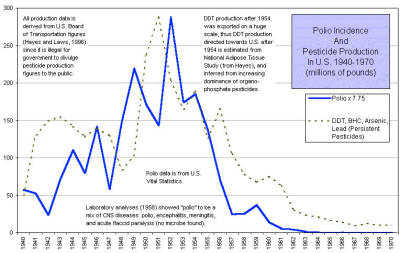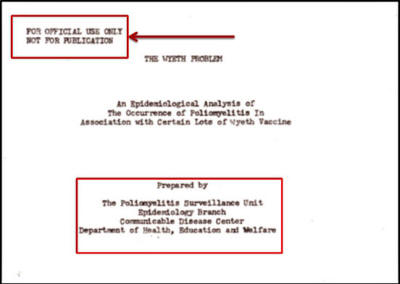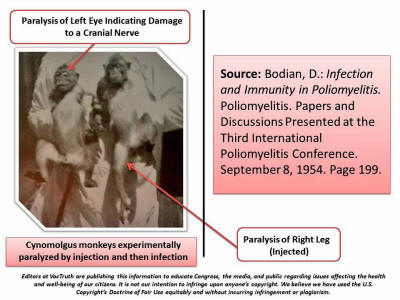|

by Jeffry John Aufderheide
June 3, 2012
from
VacTruth Website
It’s called the “Gold Standard of Medicine.”
I’m referring to the current vaccine schedule. But is there an
apparent hidden catch? Can justification for the aggressive vaccine
schedule arguably be traced back to the polio vaccine that is
trotted out as proof vaccines work?
If you don’t believe me, question any parent
on vaccines. The
knee-jerk question in almost every case is, “What about polio?”
Well, what about it? Here I discuss 7 trivia facts for readers to
investigate further about polio and question the motives of those
who would profit from vaccines and disease.
Trivia Fact #1
Chemicals Used in Pesticides
Increased Your Chance for Viral Infections
During World War II and into the 1950s, massive amounts of
pesticides, such as DDT, heptachlor, dieldrin, TEPP, malathion, were
sprayed on crops eaten by humans and livestock.
Any connection to the chemicals used in spraying the pesticide
formulations and polio epidemic are regularly denied. However, the
chemicals used in spraying pesticides were found to increase viral
infections in hosts.[1,2]
Researcher Janis Gabliks noted in the study titled, Studies of
Biologically Active Agents in Cells and Tissue Cultures, that,
“As it is recognized
that residues of some agricultural insecticides persist in the
body and that cells are continuously exposed to their
metabolites, we investigated the possibility that these
chemicals may alter certain physiological activities of cells
and subsequently influence the susceptibility of hosts to virus
infections.” [1]
Parents should also know
some of the same chemicals used to spray pesticides (Tween 20, Tween
80, Triton X-100, Nonoxyenol-9) are still present in childhood
vaccines. [3,4]
Note:
the close correlation to the spraying of pesticides and the worst
polio epidemic in US History.
“…Before 1940, relatively small
amounts of such chemicals as nicotine, rotenone, pyrethrum, and the
arsenicals were used for insect control. During and following
World War II a rapid changeover to DDT, heptachlor, dieldrin, TEPP,
malathion, and related compounds occurred.” [5]

Source:
http://harpub.co.cc/
Trivia Fact #2
Milk Was Heavily Contaminated
with Pesticides; Quietly Taken Off Shelves While Farmers Paid
By 1959, the total wholesale value in pesticide products had reached
$290 million. The massive pesticide campaign was not without cost.
[5]
According to congressional reports, many dairy farmers were
devastated from pesticides contaminating milk.
Senate Report 1363 shockingly states,
“The problem which
our dairy farmers are facing has been brought about by the use
of chemicals approved by the Federal Government to dust crops.
Some of these chemicals have been found to contaminate feeds.
The contamination
passes on into the milk and when the residues of pesticides is
found to be of too high a level, the farmers are forced to dump
their milk, taking it out of commercial channels. The result has
been disastrous to the dairy farmers involved, some of which
have had to go into bankruptcy.”
“There had been at that time, reasonable prospect that the
problem would have diminished to a point that further extension
of the authority would not have been necessary. However, as the
Department testified then, several large producers had their
milk removed from the market because of DDT residue. The problem
had in fact not been solved.
The local dairymen,
the State governments involved, dairy and cotton associations,
and the U.S. Department of Agriculture have been cooperating in
an effort to rid us of this problem. The problem, however, still
continues and it it appears that it will continue for the
foreseeable years to come.” [6]
When it was obvious
pesticide residue levels weren’t dropping as hoped, the Dairy
Indemnity Payment Program, or DIPP, officially was created through
public law in 1968 to reimburse farmers whose milk was contaminated
with pesticides. [6, 7]
Trivia Fact #3
Polio Is/Was Transmitted Through
Contaminated Milk
One of the major ways polio is transmitted is through contaminated
milk. [8-14] Even one of the inventors of the polio
vaccine, Albert Sabin, investigated the connection, [15]
he was not naïve to this information.
Expert on microbiological safety of food and water, Dean O.
Cliver, commented on the polio/milk connection in the book
Food-borne Diseases,
“Poliomyelitis was
the first reported food-borne viral disease, having been
transmitted via raw milk as early as 1914.
Raw milk predominated
as the vehicle among the 10 outbreaks recorded through 1949, the
last year in which food-borne poliomyelitis is known to occurred
in the United States or other reporting, developed countries.
Poliovirus transmission by this route ceased before the advent
of the poliomyelitis vaccines, perhaps partly because of
improved sanitation and the increased use of pasteurization of
milk.” [8]
Sagar M. Goyal noted on
page 1 of the book, Viruses in Foods,
“Food was first
recognized as a vehicle for the transmission of viruses in 1914
when a raw milk-associated outbreak of poliomyelitis was
reported (Jubb, 1915). Additional milk-borne outbreaks were
recognized after this time, but with the development of a
vaccine for poliovirus, no outbreaks were reported in the
developed world after the early 1950s.” [9]
Other common diseases
known to be spread through improper handling of contaminated milk at
the time were Tuberculosis, Typhoid Fever, Scarlet Fever, Septic
Sore Throat, Diphtheria, and Infantile Diarrhea. [16]
Can this be the genesis for all the raw milk controversy that is
going on to this very day?
Instead of promoting the
proper safe handling of certified raw milk containing many healthful
microorganisms, the U.S. FDA demands pasteurization that promotes
other health problems.
Trivia Fact #4
Removing Your Tonsils Exposed You
to the Worst Kind of Paralysis
Tonsillectomy surgery was cautioned in the presence of a polio
epidemic. [17]
It was discovered if a child had his/her tonsils removed (or even a
tooth extracted), they had a greater chance of getting the worst
kind of polio called Bulbar Poliomyelitis. [18-20]
Given the information in Trivia Fact #3, this seems to make sense
since it was common to give ice cream after a tonsillectomy.
Trivia Fact #5
Pharmaceutical Companies Funded
the writing of the “History of Poliomyelitis”
John R. Paul, M.D., an often-celebrated virologist in the
fight against polio, wrote a book entitled, A History of
Poliomyelitis. [21]
John Paul wielded significant influence and was, at the time,
considered an authority on the subject of polio.
The pharmaceutical companies,
-
Lederle Laboratories
-
Merck
-
Sharp & Dohme
-
Parke, Davis & Co.
-
Pfizer Inc.
-
Smith Kline & French,
...gave
grants to help write a pharmaceutical-friendly-version of the
history of polio.

Source: Personal
Photo of Book
Note:
VacTruth readers should also investigate the history of the
pharmaceutical companies. Geigy, now known as Novartis
Pharmaceuticals, held the patent on the pesticide DDT. Novartis now
manufacture vaccines.
The following quote was taken from the military handbook “DDT and
Other Insecticides and Repellents” regarding spraying DDT,
“The Geigy company holds the patents on the use of the compound [DDT] as
an insecticide. The United States patent is No. 2,329,074, issued
September 7, 1943, to Paul Müller.” [22]
Trivia Fact #6
A Dangerous Vaccine: Americans
Not Told Vaccine Caused Paralysis
During the polio epidemic, the Poliomyelitis Surveillance Unit (PSU)
investigated a possible association between the paralysis and the
vaccine manufactured by
Wyeth Laboratories. This incident became
known as the “Wyeth Problem.” [23,24]
The investigation was led by Neal Nathanson and was summarized in
two reports. Marked across the top of the reports are the words,
“For Official Use Only - Not for Publication” (below image.)
Why?
One plausible explanation is if Americans knew the vaccine was
causing paralysis, they would demand the vaccines be taken off the
shelf - just like any other tainted drug. Such a public outcry would
have spoiled the popularity of the polio vaccine.
The following passage from one of the reports is revealing,
“The problem was
discussed fully with officials of the Pennsylvania Health
Department. It was learned that a number of additional cases of
suspected poliomyelitis were then under investigation.
These had
been reported principally from Harrisburg and surrounding
counties in central Pennsylvania, an area where lot 236 had been
principally used in NFIP (National Foundation for Infantile
Paralysis) supported clinics. Some of these cases were known to
be “vaccine associated.”” [23]

Source:
Snapshot taken of the “Wyeth Problem” report
Trivia Fact #7
Researchers Discover How to
Paralyze Monkeys with Vaccines
During the International Poliomyelitis Conference held in 1954, Dr.
David Bodian from the Poliomyelitis Laboratory at Johns Hopkins
University discussed how his research was able to produce paralysis
in cynomolgus monkeys by vaccination. [25]
Here is how they did it:
-
First they gave
an injection with, “gelatin, corticosteroids, penicillin,
DTP (Diphtheria, Tetanus, Pertussis vaccine), saline or
merely hypodermic needle punctures…” [25]
-
Second, they
deliberately infected the monkeys with the poliovirus (this
concept is called viremia).
-
Lastly, their
observations showed, “…the paralytic rate is considerably
increased as compared with the control animals…” [25]

Bodian’s stunning
admission shortly followed,
“It must be
emphasized that the 2 experimental conditions of viremia and of
intramuscular injections, as well as the critical time period of
an interval of less than 1 month, also characterize the human
situation in epidemic areas when intramuscular injections of
penicillin or other substances [like DTP vaccine] are given.”
[25]
In other words, Bodian
is telling the attendees at the conference injections and other
vaccines, such as the DTP vaccine, “may be causing polio.”
Note:
The meeting minutes list
Albert Sabin and
Jonas Salk as speakers
during this session. Thomas Francis and Hilary Koprowski were also
present as discussants.
Consider how many injections and live virus vaccines a child now
receives in his/her first two years of life. The above information
deserves serious consideration by researchers, immunologists, and
vaccinologists.
Why is this information
important? They were all 'inventors' of a (polio) vaccine.
References
1. Gabliks J.,
Studies of Biologically Active Agents in Cells and Tissue
Cultures: Part 1. Annual Progress Report, U.S. Army Medical
Research and Development Command. 1966, p. 10. - http://www.dtic.mil/cgi-bin/GetTRDoc?AD=AD0804387&Location=U2&doc=GetTRDoc.pdf
2. Rozee, K., Spencer, H.S., Crocker, J., Safe, S. Enhanced
Virus Replication in Mammalian Cells Exposed to Commercial
Emulsifiers. Appl Environ Microbiol. 1978 February; 35(2):
297–300. - http://www.ncbi.nlm.nih.gov/pmc/articles/PMC242829/
3. Aufderheide, J., WWII Military Handbook Reveals Pesticide
Chemicals Used In Infant Vaccines. VacTruth.com. Sept. 10, 2011.
http://vactruth.com/2011/09/10/wwii-military-handbook-reveals-pesticide-chemicals-used-in-infant-vaccines/
4. Aufderheide, J., Vaccine Ingredients: Non-ionic Surfactants (Tween
80, Triton X-100, Nonoxynol -9). VacTruth.com. Aug. 23, 2011.
http://vactruth.com/2011/08/23/vaccine-ingredients-non-ionic-surfactants-tween-80-triton-x-100-nonoxynol-9/
5. Authorizing Research on Insecticides, Herbicides, Fungicides,
and Other Pesticides by the Secretary of the Interior. 85th
Congress, 2nd Session. House of Representatives Report No. 2181.
July 16, 1958.
6. Dairy Indemnity Payments. 90th Congress, 1st Session. Senate
Report 476. August 3, 1967.
7. Dairy Indemnity Payments. 90th Congress, 2nd Session. Senate
Report 1363. July 8, 1968.
8. Cliver, Dean O., Foodborne Diseases, 1990. Academic Press, p.
283.
9. Goyal, Sagar M., Viruses in Foods, 2006. Springer, p. 1.
10. Knapp, A.C, E. S. Godfrey Jr., M.D., W. L. Aycock, M.D. An
Outbreak of Poliomyelitis, Apparently Milk-borne. JAMA.
1926;87(9):635-639.
http://jama.ama-assn.org/content/87/9/635.short
11. Mathews, F., Poliomyelitis Epidemic, Possibly Milk-Borne, In
a Naval Station, Portland, Oregon. Am. J. Epidemiol. (1949)
49(1): 1-7
http://aje.oxfordjournals.org/content/49/1/1.full.pdf+html
12. Lieutenant Colonel David M. Goldstein, W. McD. Hammon, M.D.,
Dr. P.H., Henry R. Viets, M.D. An Outbreak of Polioencephalitis
Among Navy Cadets, Possibly Food Borne. JAMA.
1946;131(7):569-573. - http://aje.oxfordjournals.org/content/49/1/1.full.pdf+html
13. Rosenow, E.C., An Institutional Outbreak of Poliomyelitis
Apparently Due to a Streptococcus in Milk. The Journal of
Infectious Diseases Vol. 50, No. 5/6 (May – Jun., 1932), pp.
377-425. - http://www.jstor.org/stable/30083744
14. Aycock, W.L., Milk-borne epidemic of poliomyelitis. Amer. J.
Hyg., 7: 791-803, 1927. - http://aje.oxfordjournals.org/content/7/6/791.full.pdf+html
15. Sabin, A.B., Poliomytlitis. Preventitive Medicine in World
War II. Vol. 5 Communicable Diseases, Medical Dept. U.S. Army
Government Printing Office. 1960, pp. 367-400. - http://history.amedd.army.mil/booksdocs/wwii/communicablediseasesV5/chapter15.htm
16. Peterson, W.E. Dairy Science, Second Edition. 1950. J.B.
Lippincott Co., Chicago. pp. 553-554.
17. Poliomyelitis. Papers and Discussions Presented at the First
International Poliomyelitis Conference. Third Session – Tuesday
July 13, 1948. J.B. Lippincott Co., Chicago. p. 119.
18. Aycock, W.L. and Luther, E.H., The occurrence of
poliomyelitis following tonsillectomy. New Engl. J. Med., 200:
164, 1929.
19. Aycock, W.L. Tonsillectomy in Poliomyelitis. JAMA.
1944;125(14):990. doi: 10.1001/jama.1944.02850320048022 -
http://jama.ama-assn.org/content/125/14/990.3.full.pdf+html
20. Francis T., Krill, C.E., Toomey, J.A. and Mack, W.N.,
Poliomyelitis following Tonsillectomy in five members of a
family. JAMA. 1942;119(17):1392-1396. doi:
10.1001/jama.1942.02830340004002 - http://jama.ama-assn.org/content/119/17/1392.full.pdf+html
21. A History of Poliomyelitis. New Haven: Yale University
Press, 1971. ISBN: 0-300-01324-8.
22. “DDT and Other Insecticides and Repellents.”Miscellaneous
Publication No. 606, United States Department of Agriculture. p.
3, Issued August 1946.
23. Nathanson, N. The Wyeth Report: An Epidemiological
Investigation of the Occurrence of Poliomyelitis in Association
with Certain Lots of Wyeth Vaccine. August 31, 1955.
24. Nathanson, N. The Wyeth Report: An Epidemiological
Investigation of the Occurrence of Poliomyelitis in Association
with Certain Lots of Wyeth Vaccine. March 1957.
25. Bodian, D., Infection and Immunity in Poliomyelitis.
Poliomyelitis. Papers and Discussions Presented at the Third
International Poliomyelitis Conference. Wednesday Morning –
September 8, 1954. J.B. Lippincott Co., Chicago. pp. 199-202.
|




